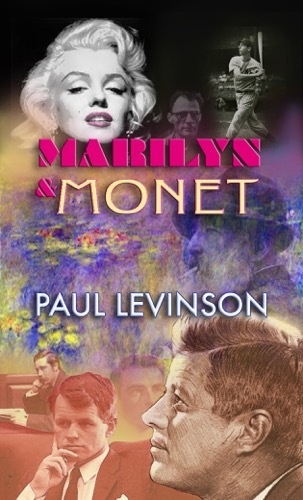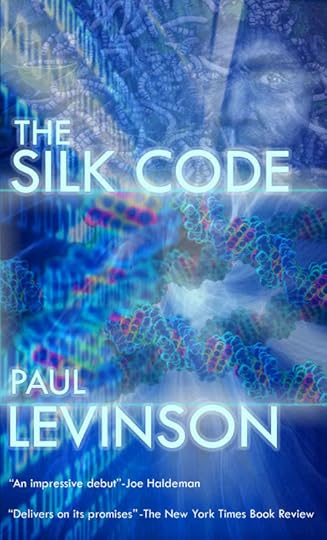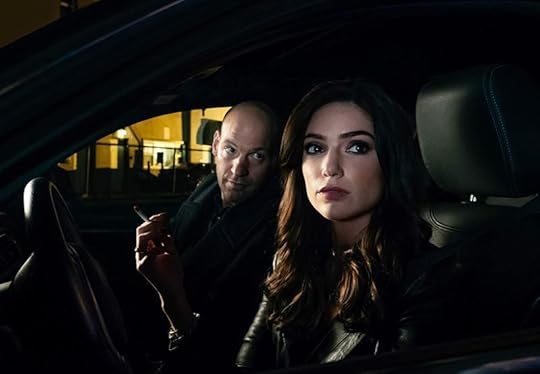Paul Levinson's Blog: Levinson at Large, page 178
October 24, 2018
Making a Murderer: Frightening Reflection of Justice in America
Welcome to Light On Light Through, Episode 112, in which I review Making a Murderer, both seasons. These 20 episodes should be required viewing for anyone who wants to see the reality of our justice system in America.
Relevant links -
1. my blog post (written) review of the first season
2. my blog post (written) review of the second season
3. a report about my experience as jury foreperson (May 2013) on a different case, in New York
Paul Levinson's books ... Paul Levinson's music
Published on October 24, 2018 17:43
October 22, 2018
Manifest 1.5: "It's All Connected"

Finally, a glimmer of progress in understanding what is going on in Manifest - in tonight's episode 1.5 - just a glimmer.
It comes from Cal, who become the first of the passengers on the flight that skipped ahead in time to not hear an instructive voice, but be the speaker of that voice. His father Ben is the one who hears it.
The voice says "It's all connected". Ben first hears the voice, several times, and then hears Cal say it after he leads them on a wild little run through a New York City subway station. Well, everyone knows that our subway system here in New York is all connected. But there's much more to this statement, which could become the "save the cheerleader" of Manifest.
Because, at the end of the episode, we see Cal awake when his family and everyone around him on the plane are sound asleep. And he looks out the window, looks into the shimmer that's out there, and again says "It's all connected". Actually, not again, but the first time. And then cut to black, or, at least, the credits or whatever ends the episode.
So this means that Cal has seen something of what is really going on - what it was that took the plane to the future - and his description of it, is "It's all connected". Not only that. The phrase is his first description, and also his continuing description.
That strikes me as pretty important, though I still haven't more than clue as to what's going on. But it's a spark and a start.
See also Manifest 1.1: Canterbury Voices ... Manifest 1.2: Arthur C. Clarke's Magic ... Manifest 1.3: The Murdered Passenger ... Manifest 1.4: Precious Little Time Travel

Paul Levinson's books ... Paul Levinson's music
Published on October 22, 2018 20:32
The Romanoffs 1.3: House of Special Purpose: Meta Ghost Story

The Romanoffs 1.3, entitled House of Special Purpose, is the most conceptually ambitious and sophisticated of the standalone episodes so far. It's also closest to my favorite genre as a reader, viewer, and writer - science fiction - and it stars Christina Hendricks, who was one of the leading lights on Mad Men.
She gives an outstanding performance as Olivia Rogers, an actress who flies to a windy part of Europe to play the Tsarina Alexandra Romanov in a six-part television series about the Romanovs. That's what I mean about this excellent episode being meta. (By the way, the offs is an Anglicized alternate spelling of the ovs in The Romanoffs.)
The ghost part, which is not really science fiction but dark fantasy, is why I said ghost story - science fiction and fantasy can be French-kissing cousins. In House of Special Purpose, there's some serious kissing going on, against a backdrop of Olivia bumping into another reality in which she really is Alexandra, or at least some kind of real Romanov. (Hey, alternate reality is ipso facto science fiction, too.) She encounters people who speak Russian who in fact apparently do not. Passions and memories from the real Tsar and Tsarina and Rasputin are afoot though not in the script. Olivia struggles to understand what is going on, be professional in her acting, but that becomes increasingly difficult. I won't tell you the powerful ending, but let's just say that hotel in which she is staying is even more possessive than the Hotel California.
There's dark humor sprinkled into this episode along with the straight-up fright, and lots of inside wit about the TV and movie industry. A superb episode as good as the second, which I said last week was the best so far. See you back here after the next.
See also: The Romanoffs 1.1: The Violet Hour: Compelling, Anti-Binge Watchable Comedy of Manners ... The Romanoffs 1.2: The Royal We: A Walk on the Dark Side

It all starts in the hot summer of 1960, when Marilyn walks off the set
of The Misfits and begins to hear a haunting song in her head,
"Goodbye Norma Jean" ... Paul Levinson's books ... Paul Levinson's music
Published on October 22, 2018 07:49
October 21, 2018
Making a Murderer 2: The Very Pits of Justice

My wife and I binge-watched the second season of Making a Murderer on Netflix the past few evenings. In an America brought to new levels of injustice and anger and despair courtesy of Trump, and commitment to vote him and his Republicans out of office as soon as possible, the story of what happened to Steven Avery and Brendan Dassey provides yet another totally separate example of the decline and miscarriage of justice in America, in this case due to police, prosecutors, and judges, including the U. S. Supreme Court.
The facts are these:
Brendan Dassey confessed, when he was 16-years old, to murdering Teresa Halbach. There is no forensic evidence whatsoever to implicate him in the crime. Yet he was convicted and sentenced to life in prison. The video in which he gave his confession couldn't be more clear: he is not very bright, and he's fed imagined details of the crime by his questioners. They told him what they needed to hear, over and over again, until he was able to mouth the words of his confession. All of that is laid out, in detail sickening for justice, in Season 1.
Laura Nirider and Steven Drizin take up his defense in Season 2. They get no justice for their client in Wisconsin courts. Their only option is to appeal in Federal courts. This has become very difficult, given AEDPA (Anti-Terrorism and Effective Death Penalty Act), passed overwhelmingly by Congress and signed into law by, yes, Bill Clinton in 1996. This law instructs Federal judges to be extraordinarily careful in overturning convictions for murder in state courts. Nonetheless, a Federal district court judge did just that for Dassey. Wisconsin could have released him, but they chose to appeal. A three-judge Appellate panel (7th Circuit) upheld the district judge. Wisconsin appealed again, this time to the full 7th Circuit, which decided 4 to 3 that nothing untoward happened in Dassey's interrogation or subsequent conviction. Nirider and Drizen took the case to the U.S Supreme. Four justices were needed to get the High Court to consider the case. That requisite number could be not attained, and the Supreme Court declined to hear the case, this past June.
The villains in this outrage: Wisconsin Attorney General Brad Schimel, the at least six Justices on the U. S. Supreme Court who were uninterested in hearing Dassey's case, and Bill Clinton, who should have at least have had the integrity to veto AEDPA (even though Congress would've overridden his veto).
The result: a young man, now in his late 20s, is on his way to spending most of his life in prison, based on a confession that one of the judges in the 7th circuit said makes her "skin crawl" due to how unfair it was.
I suppose, if Steven Avery's conviction is overturned, that Brendan Dassey may have another chance. Avery served 18 years in prison for a rape he didn't commit - DNA evidence cleared him - before he was arrested and convicted for Halbach's rape and murder. He never confessed. He was convicted on forensic evidence that his new lawyer, Kathleen Zellner, has systemically shown was concocted and planted. Scientific experts say the following: Blood in the car in which Halbach's body was allegedly thrown has a splatter pattern totally inconsistent with that. Same for blood that allegedly came from Avery. A bullet fragment that allegedly passed through Halbach's skull and brain shows no traces of phosphorous which would be there if the bullet went through bone. The burn pit on the Avery property in which her body was allegedly all but cremated could not have generated the heat necessary for that sort of total consumption in the flames. Etc, etc.
Zellner has also suggested a variety of alternative suspects, including Brendan's brother Bobby and his step-father Scott. When the final episode of the second season ends, she has achieved at least the positive result of an Appeals Court in Wisconsin ordering the lower court to have a new evidentiary hearing on the case.
The effect on the Avery family, as well as the Halbach family, has been devastating. Steven's parents are in their 80s, and everyone worries, with due cause, that they may pass away before their son is released. Zellner's pointing at Brendan's brother and stepfather as the possible murderers has, of course, set Brendan's mother against Zellner, and her brother Steven Avery, too.
But such is the state of justice in America in 2018. It doesn't and shouldn't matter if I or anyone is 100% sure that Steven and Brendan didn't do this heinous crime. I am 100% sure that there's more than enough reasonable doubt, in dozens of places. Why more judges and Justices haven't seen that is cause for concern not only about out justice system, but about the human condition itself.
See also Making a Murderer 1: Showing Us the Truth about Our Unjust Justice System
Paul Levinson's books ... Paul Levinson's music
Published on October 21, 2018 21:28
October 17, 2018
Mayans M. C. 1.7: The Conversation

An excellent episode 1.7 of Mayans M. C. last night, the most significant part of which, I thought, was a conversation between "Felipe" (in quotes because it's not his real name) and "Adelita" (not her real name, either) who comes to kill him. (Last week's episode 1.6 was outstanding, too, but I didn't have a chance to review it. Please don't tell the Club.)
Back to Adelita and Felipe, she comes to kill him on a mission of revenge, to kill the traitor who sold out her father, resulting in his murder and along Adelita's mother and brother. Felipe sets her straight. He was her father's partner. But there was a third partner, and he was the one who sold Adelita's father out. The conversation ends with the two of them pledging to pool their resources. This could be the most important new alliance so far in Mayans M. C. And the mixing of prior and current generations and secrets revealed is consistent with the motif of Sons.
As a result of this new alliance, Galinda and his son are released, and the family is joyfully reunited. But their joy is short lived. Lincoln Potter and his team descend upon the Galindas like a nest of angry hornets, and the episode ends with Galinda in far worse shape than he was in the Mexican prison.
This is also consistent with what was so compelling in Sons of Anarchy: our heroes (or anti-heroes, and heroines) never run out of mortal enemies. They come from rivals, from presumed and/or former friends and allies, from family, from the past, and of course from the law itself. This means that every one of our characters is in a state of perpetual jeopardy. The only way you can be liberated from that - other than being killed - is to leave the area, as some main characters did in Sons, especially at the end. But it doesn't look like anyone is about to do that in Mayans, which means we're in for some pretty powerful viewing in the episodes and seasons ahead.
See also: Mayans, M. C. 1.1: Pulling Us In ... Mayans M. C. 1.2: The Plot Thickens ... Mayans M. C. 1.3: Two Presidents ... Mayans M. C. 1.4: Finger and Face ... Mayans M. C. 1.5: "Not Fredo" - "Putas and Plata"

Paul Levinson's books ... Paul Levinson's music
Published on October 17, 2018 14:29
October 15, 2018
Manifest 1.4: Precious Little Time Travel

Well, as of Manifest 1.4 tonight, the series about a plane that jumped five years into the future continues to meander around with stories that advance the time travel story not one bit.
Tonight's big deal was discovery of a stowaway passenger with mental problems. That, and the visions our passengers see involve a grey woman with wings (for one of the viewers) and feet that make wet footprints (for the other viewer). Not the stuff that great or even good time-travel science fiction is made of.
Indeed, the most interesting part of the episode is passenger Ben Stone's continuing struggle to get close to his wife and his daughter, each of whom aged five years while he was on that "magical" flight. But this is a dysfunctional family dynamic not dependent on time travel - Stone could be facing the same problems if he were away from his family for any reason, having nothing to do with time travel.
All of which is to say: the only reason I'm watching this series is because I'm a devotee anything concerning time travel. In fact, I just gave a talk about why time travel is so enjoyable as a form of fiction at the New York State Communications Association 76th Annual Conference on Saturday. You can see the video below.
But there's precious little time travel in Manifest, and I don't know how much more time I'll give it.
See also Manifest 1.1: Canterbury Voices ... Manifest 1.2: Arthur C. Clarke's Magic ... Manifest 1.3: The Murdered Passenger

Paul Levinson's books ... Paul Levinson's music
Published on October 15, 2018 20:19
October 14, 2018
The Deuce 2.6: "Bad Bad Larry Brown"

Larry Brown had the most best scenes in The Deuce 2.6 tonight. His acting not only animates Candy's Little Red Riding Hood feature, but he's a first-class ad-lib writer, and his being beaten by cops who mistake him for the real thing when he's chasing Lori in the streets of New York leads to Candy getting a much-needed twenty grand for her movie. Not bad for an hour's work in The Deuce - creds to Gbenga Akinnagbe in the role - and it more than justifies Candy calling him "bad bad Larry Brown" in an homage to Leroy. (Hey, I was too busy to review last week's episode, but I'm back now, from outer space.)
Meanwhile, Candy does some fine acting herself (and Maggie Gyllenhaal some fine acting as Candy) after she insists that Frankie fire his wife for her poor portrayal of Grandma and Candy plays the part herself. And I have to say that I was completely wrong when I said that Frankie seemed to be fading from the show a few weeks ago. In this and last week's episode, he's had a much stronger part than Vincent.
About that, Vincent's second thoughts about his life with the pimps and parlors is a bit trite and even boring. The Vincent we've come to know always surmounted his doubts and gets on top of the situation. In contrast to Frankie, who makes a silk purse out a sow's ear, or something like that, Vincent seems to sinking into a morass of self-doubt and pity. But kudos to James Franco for consistently good acting in this double role. (And while I handing out praise, I've been meaning to say how much I like the rendition of Elvis Costello's great 1978 "This Year's Girl" that plays at the start of very episode. The vid of Costello original singing of his song is right below.)
Still unresolved is what's going to happen with CC and Lori. He has contempt for Larry and his acting - remarking that he's no longer a pimp - and he's putting up with Lori only because she's still giving him her earnings. But this unstable situation can't last, and I'll be back here next and the weeks ahead to review how it all explodes, falls apart, or resolves.
See also The Deuce Is Back - Still Without Cellphones, and that's a Good Thing ... The Deuce 2.2: Fairytales Can Come True ... The Deuce 2.3: The Price ... The Deuce 2.4: The Ad-Lib
And see also The Deuce: NYC 1971 By Way of The Wire and "Working with Marshall McLuhan" ... Marilyn Monroe on the Deuce 1.7 ... The Deuce Season 1 Finale: Hitchcock and Truffaut

It all starts in the hot summer of 1960, when Marilyn walks off the set
of The Misfits and begins to hear a haunting song in her head,
"Goodbye Norma Jean" .. Paul Levinson's books ... Paul Levinson's music
Published on October 14, 2018 20:26
October 12, 2018
The Romanoffs 1.2: The Royal We: A Walk on the Dark Side

Well, The Romanoffs 1.2, entitled The Royal We, takes a darker, nastier, murderous turn, with none of the comedy of the first episode (The Violet Hour), unless you find dwarfs acting as the royal family Romanoffs (Romanovs) on a cruise to celebrate the family, funny.
But the evil stuff was pretty compelling. Michael Romanoff (exceptional acting by Corey Stoll) has no happiness in his life, including with his wife Shelly, though that's for no want of her trying. He finds himself on a jury for a murder trial, obligating Shelly to go on the cruise she booked for the two of them on her own. Michael seems to hit pay dirt on the jury. A beautiful former ballet dancer, Michelle, is on it, too. He's instantly smitten. He deliberately extends the deliberations by refusing to find the obviously guilty defendant guilty. He soon contrives to meet with the dancer when the jury takes a break for the weekend - they're not sequestered - and manages to sleep with her after she more or less seduces him. Meanwhile, in contrast, Shelly says no to handsome Ivan, in a corridor near the door of her room on the boat, after they kiss and he clearly indicates his intentions.
She returns to a powder keg of Michael wanting to see more of Michelle, and she demurring (she's married, too). I won't tell you anymore lest I give too much away, but the intensity of what happens is reminiscent of both The Sopranos and Mad Men and Heather, the Totality in different ways. Weiner is not only a master of societal foibles, but the ugliest, harrowing facets of human nature.
With two episodes of The Romanoffs now on the screen, we can see that they're as different as day and night. What Weiner is really after in this new anthology is telling very different stories, with no connection to one another whatsoever, except for the Romanoff label.
Which makes me wonder about the subsequent episodes even more, and want to see them. I'll be back here next Friday with a review of #3.
See also: The Romanoffs 1.1: The Violet Hour: Compelling, Anti-Binge Watchable Comedy of Manners

It all starts in the hot summer of 1960, when Marilyn walks off the set
of The Misfits and begins to hear a haunting song in her head,
"Goodbye Norma Jean" ... Paul Levinson's books ... Paul Levinson's music
Published on October 12, 2018 21:58
The Romanoffs 1.1: The Violet Hour: Compelling, Anti-Binge Watchable Comedy of Manners

I've been a fan of Matthew Weiner's since The Sopranos and Mad Men. So has my wife. I even read and rave-reviewed his 2017 novella Heather, The Totality. So of course we were going to watch The Romanoffs, the new anthology series on Amazon Prime, now consisting of eight standalone 90-minute episodes connected by the sinew of each episode tells the story of a different character or characters who think they are descendants of the royal Russian family, all or most of whom were slain by the Bolsheviks in 1918. The first two episodes were put up today, and the rest will be shown on a weekly basis.
All ninety minutes of The Violet Hour were excellent. The story takes place in Paris, featuring Anushka (who claims she is a descendant), her American nephew Greg, his French girlfriend Sophie, and Anushka's caretaker Hajar, who was born in Paris and whose parents came from North Africa. There's comedy, profundity, passion, and surprises all packaged in this tale of how Anushka is determined to see that her Romanoff bloodline survives into the next generation.
The genre is so original it's hard to classify. It has elements of Downton Abbey and Woody Allen. It would have been a good standalone movie, and someone said somewhere that these episodes could be watched and considered as individual movies. But the fact that Weiner has tied them all together by this unlikely thread makes them all the more appealing - or, at least, that's what I thought before watching the first episode and even more strongly now.
Weiner's decision not to show them all at once certainly supports the each episode is a movie structure. As such, The Romanoffs could be considered the first deliberately anti-binge-watchable series on a streaming service. I'm not sure how I feel about that - we're going to watch the second the episode as soon as I post this review. I know we'd want to watch the third, if not right after the second, at least tomorrow night,
But The Violet Hour was so good we'll be happy to wait for that third, next week.
See also The Romanoffs 1.2: The Royal We: A Walk on the Dark Side

It all starts in the hot summer of 1960, when Marilyn walks off the set
of The Misfits and begins to hear a haunting song in her head,
"Goodbye Norma Jean" ... Paul Levinson's books ... Paul Levinson's music
Published on October 12, 2018 19:41
October 9, 2018
Farewell Elton John at Nassau Coliseum

Tina and I just got back from Elton John's fabulous Farewell Yellow Brick Road Concert at the Nassau Coliseum. This is the third retiring tour concert we've been to in the past few weeks - Paul Simon and Joan Baez were the previous - and each was superb and special in its own way.
Elton John's music has played a surprisingly significant role throughout my professional life - surprising not because his songs (with lyrics by Bernie Taupin) have been wonderful, numerous, and memorable, but because they've had such diverse impact on my own creative work.

Most recently, my novelette, Marilyn and Monet, maybe in the earliest stages of being made into a movie, begins with Marilyn hearing "Candle in the Wind" as she walks off the set of The Misfits with Montgomery Clift in 1961 (hey, it's a science fantasy story).
Back when I began my life as a published writer, the fourth article I wrote for The Village Voice was inspired by "Goodbye Yellow Brick Road" - an assessment of how the Wizard of Oz figured in rock music in its first decades. Never read that article? Not surprising. The Village Voice - or rather its then new music editor, dyspeptic critic Robert Christgau, declined to publish it, after his predecessor Diane Fischer had published my first three articles ever published, all about music. (I tell more of that story here.)
And Elton John's "Rocket Man" has had more long range influence on my work. One of the few rock songs that were science fiction, it epitomized my passion as a writer for both rock music and science fiction. And, indeed, I'll soon be recording a brand new album of my songs with science fiction themes for Old Bear Records in Batavia, New York.

Elton John sang all of these and 21 more at his concert tonight. He hit most of the notes beautifully, and his back-up band was tight as a drum. I've admired Ray Cooper even since I saw the way he played the tambourine in the George Harrison Memorial Concert. It was a real treat seeing him in person, singing "pow, pow, pow" as he beat the bejesus out of the drums and anything percussive he could hit.
Elton's repartee was clever, but, more important, he comes across as one decent, sincere human being. The graphics on the screen behind him were a tour de force. I'm glad I had a chance to see him in person. I know I'll continue singing his songs in my head, and who knows what big things that may lead to.

Paul Levinson's books ... Paul Levinson's music
Published on October 09, 2018 22:50
Levinson at Large
At present, I'll be automatically porting over blog posts from my main blog, Paul Levinson's Infinite Regress. These consist of literate (I hope) reviews of mostly television, with some reviews of mov
At present, I'll be automatically porting over blog posts from my main blog, Paul Levinson's Infinite Regress. These consist of literate (I hope) reviews of mostly television, with some reviews of movies, books, music, and discussions of politics and world events mixed in. You'll also find links to my Light On Light Through podcast.
...more
- Paul Levinson's profile
- 342 followers



